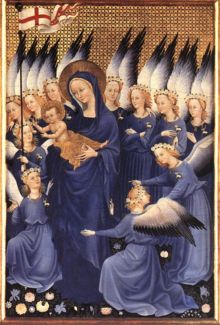Livery

A livery is a uniform or other sign worn in a non-military context on a person or object (such as an airplane) to denote a relationship with a person or corporate body, often by using elements of the heraldry relating to that person or body, or a personal emblem, and normally given by them. It derives from the French livrée, meaning delivered. Most often it would indicate that the person was a servant, dependent, follower or friend or the owner of the livery, or, for objects, that the object belonged to them.
In the 1300s, "livery" referred to an allowance of any kind (for instance the city of Exeter in Devon, England has a street called "Livery Dole" after the Livery Dole Almshouses and Chapel, founded in March 1591), but especially clothes delivered to servants and members of the household. Such things might be kept in a "livery cupboard."
The term is also used to describe badges and grander pieces of jewellery containing the heraldic signs of an individual, which were given by that person to friends, followers and distinguished visitors, as well as (in more modest forms) servants. William, Lord Hastings the favourite of King Edward IV of England had a "Coller of gold of K. Edward's lyverys" valued at the enormous sum of £40 in an inventory of 1489. This would have been similar to the collars worn by Hastings' sister and her husband Sir John Donne in the Donne Triptych by Hans Memling (described in Sir John Donne).[1]
The sense later contracted to servants' rations and distinctive standardized outfits, often in a colour-scheme distinctive to the family, like the coats worn by footmen in grand houses until World War I, and to provender for horses, from which we have inherited "livery stable" (1705) [1].
From this core meaning, multiple extended or specialist meanings have derived. Examples include:
- A livery company is one of the most ancient guilds of the City of London; members of the company were allowed to dress their servants in the distinctive uniform of their trade, and the company's charters enabled them to prevent others from embarking upon the trades within the company's jurisdiction. In Paris, similar institutions, called Corporations were swept away by the Revolution.
- Following on from the decoration of horse-drawn carriages, a livery is the common design and paint scheme a company will use on its vehicles, often using specific colors and logo placement. In this sense, the term is applied to railway locomotives and rolling stock, aircraft, and road vehicles. For example, United Parcel Service has trucks with a well-known brown livery. Another example is the British Airways ethnic liveries. The term has become extended to the logos, colors and other distinctive styles of companies in general. See also trade dress.
- A livery is the specific paint scheme and sticker design used in motorsport, on vehicles, in order to attract sponsorship and to advertise sponsors.
- A "livery vehicle" remains a legalism in the U.S. for a vehicle for hire, such as a taxicab or chauffered limousine, but excluding a rented vehicle driven by the renter. In some jurisdictions a "livery vehicle" covers vehicles that carry up to seven passengers, but not more, thus including a jitney but excluding an omnibus or motorcoach. This usage stems from the hackney cabs or coaches that could be provided by a "livery stable." By extension, Canada has many businesses offering canoe livery.
The term is now rarely if ever applied in a military context, so it would be unusual for "livery" to refer to a military uniform or the painting of a military vehicle. Early uniforms were however regarded as a form of livery ("the King's coat") in the late 17th and early 18th centuries.
references
- ↑ National Gallery Catalogues: The Fifteenth Century Netherlandish Paintings by Lorne Campbell, 1998, ISBN 185709171 - Hastings' collar p389 n88
